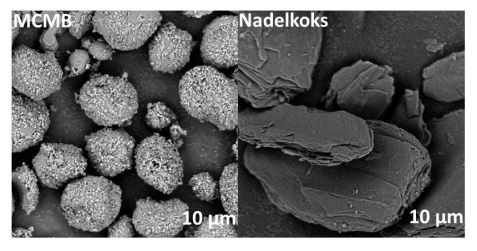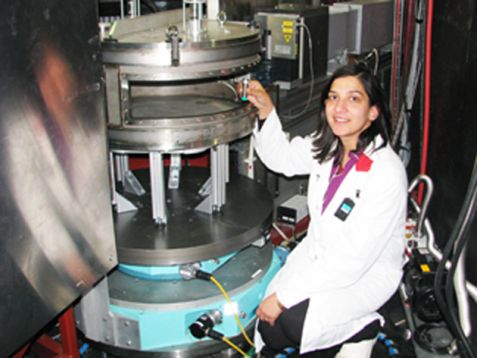MLZ is a cooperation between:
 > Technische Universität München
> Technische Universität München > Helmholtz-Zentrum Hereon
> Helmholtz-Zentrum Hereon
 > Forschungszentrum Jülich
> Forschungszentrum Jülich
MLZ is a member of:
 > LENS
> LENS > ERF-AISBL
> ERF-AISBL
MLZ on social media:

MLZ (eng)
Lichtenbergstr.1
85748 Garching
24.03.2017
The lost lithium: Neutrons explain the aging in battery cells used in stationary storage systems
Together with the VW-VM research company, a collaboration between VW and VARTA Microbattery, scientists from the Heinz Maier-Leibnitz Zentrum (MLZ, working group Dr. Ralph Gilles) and the chair of Technical Electrochemistry (Prof. Hubert Gasteiger) of the Technical University of Munich have now investigated for the first time the aging of battery cell prototypes for stationary storage systems with the help of neutrons on the instrument SPODI. Results of these measurements clearly showed that the aging of the batteries under investigation is caused exclusively by the loss of active lithium ions.
Batteries consisting of lithium iron phosphate (LFP) and graphite are often used for stationary energy storage systems. They have to be cycled more than 5000 times, so they have to last much longer than, for example, cell phone batteries. LFP batteries can be based on different types of cell components, which can have a strong influence on their lifetimes. The main questions for the scientists are: What are the reasons for the loss of storage capacity? What happens inside the battery cell? Neutrons are ideal probes to solve these questions. They penetrate into the interior of the battery cells without destruction and provide information about the exact chemistry and structures from the cell interior. Dr. Neelima Paul of the Heinz Maier-Leibnitz Zentrum and Johannes Wandt of the Chair of Technical Electrochemistry have for the first time investigated prototypes for stationary storage systems of the VW-VM research company with neutron diffraction.

Scanning Electron Microscopy pictures of the two anode materials examined:needle coke and MCMB. © Varta
The scientists examined two different types of batteries: the so-called MCMB batteries contained graphite in the form of highly structured microspheres; the so-called Needle Coke batteries contain graphite with a platelet-like structure. In order to investigate the aging behavior, one cell of each type was stored for two years and one was cycled approximately 5000 times. The researchers then investigated all four batteries at the neutron powder diffractometer SPODI at the MLZ with the help of the instrument scientists, Dr. Martin Mühlbauer and Dr. Oleksandr Dolotko. The MCMB cell showed only a relative loss of capacity of 8% after the approximately 5000 cycles, and after the two-year storage even a slight capacity gain by 1.5%. On the other hand, the Needle Coke cell disappointed with a relative capacity loss of 23.1% after cyclic aging and 10% less storage capacity after two years of storage. In the search for reasons for the loss of capacity, Dr. Neelima Paul and her colleagues found that the active lithium ions, which migrates between anode and cathode, is lost. It probably collects itself in the so-called Solid Electrolyte Interface (SEI) layer, which thereby permanently grows. “It looks as if the platelet-like structure and larger basal to edge plane ratio of the needle coke anode favors the aging of the battery cells,” says Dr. Neelima Paul.
The neutron diffraction measurements of Dr. Neelima Paul and Johannes Wandt excluded other causes: for example, that the cathode material is structurally degraded or the contact between the active electrode materials and the current collector is lost. This is important for VARTA, as Dr. Sebastian Schebesta of VW-VM emphasizes. “This is how we know that we are using the right material mix with the MCMB for these batteries and can therefore continue to work with these anodes to make stationary storage batteries.”
The work was supported by the Bavarian Ministry of Economic Affairs within the framework of the EEBatt project.
Original publication:
Aging behavior of lithium iron phosphate based 18650-type cells studied by in situ neutron diffraction
Neelima Paul; Johannes Wandt; Stefan Seidlmayer; Sebastian Schebesta; Martin J Mühlbauer; Oleksandr Dolotko; Hubert A Gasteiger; Ralph Gilles
Journal of Power Sources 345 (2017) 85-96
http://dx.doi.org/10.1016/j.jpowsour.2017.01.134
MLZ is a cooperation between:
 > Technische Universität München
> Technische Universität München > Helmholtz-Zentrum Hereon
> Helmholtz-Zentrum Hereon
 > Forschungszentrum Jülich
> Forschungszentrum Jülich
MLZ is a member of:
 > LENS
> LENS > ERF-AISBL
> ERF-AISBL
MLZ on social media:




